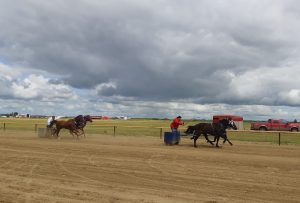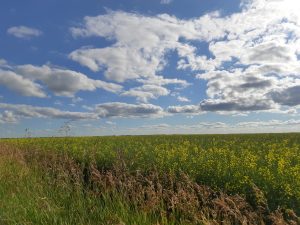by Eric Epp
Visting Batoche in June was a solitary, reflective experience—no other cars in the parking lot and nobody closer than whoever was mowing the lawn of the church on One Arrow—but whew it was another story at the end of July, because it was finally Back to Batoche and just about everyone who was Métis or had Métis friends or wanted to camp out at Batoche with the Métis was rolling in, setting up, kicking back, and catching up! The line-up of cars stretched down the highway but my grandma’s Camry (and my wristband) demanded the red carpet so I skipped the queue and got wandering.
Four of the big Métis provincial organizations (BC, Alberta, Saskatchewan, and Ontario) had official spaces, but this weekend was a break from politics, and except when fiddlers set up in front of the Métis Nation-Saskatchewan area, the line-ups were for bannock burgers, porta-potties, and the never-ending rotation of bands playing the mainstage. Me, though, I was on a mission—I’d checked the schedule and was ready to finally engage with the core stuff of my legal internship: chuck wagon races! I got to the track and leaned up against the fence next to a backed-up pick-up truck, ready to watch some horses go round.

They were mostly young guys hanging out in the bed of the pick-up, and they knew everyone and everyone knew them. Some were older and had to make a show of maturity to rein in the kids, but the kids didn’t mind because they were all sitting in the same pick-up bed anyways and everyone knew that. People hopped up and hopped down: some entered into the web of relationships seamlessly and others had to test the water; one kid wandered over from the track with a cigarette dangling from his mouth, acting a bit cooler than he was and the older guys had to tease him a bit. A dynamic, self-supporting web of relationships was the law of the truck bed…what a clumsy analogy for Métis law but I mean it! When the Métis of St Laurent assembled in 1873 to hash out some laws (after the horrors of 1869–70 in Red River pushed them west), they met as equals, bound together by real and fictive kinship networks—and when Gabriel Dumont was elected President, this web of relationships was the law that held him accountable, the law that guaranteed individual freedoms, and the law that resolved disputes: relationships were the building block of law, and the Métis web of relationships intersected and interacted with, overlapped with and bled into, all the other human and natural relationships that spread across the plains.

From Batoche it’s about a twenty minute drive south-west to Rosthern, where my parents met when their parents sent them to Rosthern Junior College, arguably the definitive Mennonite high school on the prairies. Duck Lake, site of another 1885 clash, is about a fifteen minute drive north from Rosthern—and if I had driven farther north and west into Saskatchewan, I would have come to where both my sets of grandparents either grew up or established roots. When my Mennonite relatives went into town they would have rubbed shoulders, well, maybe not rubbed shoulders, and maybe not even exchanged glances with, but certainly encountered the Métis they shared the land with: their relationship with the land undeniably put them in a relationship with the Métis, and with all other peoples sharing the land, even those not starting with M.
I am writing this from McGill’s law library, but even from the position of starting my second year of law school, it’s undeniable that I too, in however small and uncertain a way, am part of the web of relationships that stretches across the plains. Western law rejects and attacks the legal significance of these relationships, but their existence is fact: sometimes tattered, sometimes stretched, sometimes even twisted into nastiness and violence, but always fact and always yearning to be healthy. I hope this tribunal project will help mend at least a few relationships.
